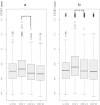Observational multicenter study to evaluate the prevalence and prognosis of subclinical atheromatosis in a Spanish chronic kidney disease cohort: baseline data from the NEFRONA study
- PMID: 25326683
- PMCID: PMC4210528
- DOI: 10.1186/1471-2369-15-168
Observational multicenter study to evaluate the prevalence and prognosis of subclinical atheromatosis in a Spanish chronic kidney disease cohort: baseline data from the NEFRONA study
Abstract
Background: Cardiovascular events (CVE) are more prevalent in chronic kidney disease (CKD) than in general population, being the main cause of morbimortality. Specific risk factors related to CKD have been suggested, because traditional factors do not fully explain this increase in cardiovascular disease rates. However, the role of atheromatosis, its pathogenesis and evolution are still unclear. The potential use of diagnostic tests to detect subclinical atheromatosis has to be determined.
Methods: NEFRONA is a prospective multicenter cohort study. 2445 CKD subjects were enrolled from 81 Spanish hospitals and dialysis clinics, from 2010 to 2012. Eligibility criteria included: 18 to 74 years old, CKD stage 3 or higher, and no previous CVE. 559 non-CKD controls were also recruited. Demographical, clinical and analytical data were collected. Carotid and femoral ultrasounds were performed by a single trained team to measure carotid intima-media thickness (cIMT) and detect atheromatous plaques. Ankle-brachial index (ABI) was measured.
Results: Differences in age, sex and prevalence and control of cardiovascular risk factors were found between controls and CKD patients. These differences are similar to those described in epidemiological studies.No difference was found regarding cIMT between controls and CKD (when subjects with plaques in common carotid arteries were omitted); earlier CKD stages had higher values. CKD patients had a higher rate of atheromatous plaques, with no difference between stages in the unadjusted analysis. A group of patients had plaques in femoral arteries but were plaque-free in carotid arteries, and would have gone underdiagnosed without the femoral study. The percentage of pathologic ABI was higher in CKD, with higher prevalence in more advanced stages, and a higher rate of ABI >1.4 than <0.9, suggesting more vascular calcification.
Conclusions: NEFRONA is the first large study describing the actual prevalence of subclinical atheromatosis across different CKD stages. There is a very high rate of atheromatous plaques and pathologic ABI in CKD. Prospective data will add important information to the pathogenesis and evolution of atheromatosis in CKD, compared to non-CKD subjects.
Figures



References
-
- U.S. Renal Data System . USRDS 2013 Annual Data Report: Atlas of Chronic Kidney Disease and End-Stage Renal Disease in the United States. Bethesda, MD: National Institutes of Health, National Institute of Diabetes and Digestive and Kidney Diseases; 2013.
-
- Sarnak MJ, Levey AS, Schoolwerth AC, Coresh J, Culleton B, Hamm LL, McCullough PA, Kasiske BL, Kelepouris E, Klag MJ, Parfrey P, Pfeffer M, Raij L, Spinosa DJ, Wilson PW. Kidney disease as a risk factor for development of cardiovascular disease: a statement from the American heart association councils on kidney in cardiovascular disease, high blood pressure research, clinical cardiology, and epidemiology and prevention. Circulation. 2003;108:2154–2169. - PubMed
-
- Rubin C, Nolin TD, Himmelfarb J. Are biomarkers useful for assessing cardiovascular risk in patients with chronic kidney disease? Curr Opin Nephrol. 2007;16:506–511. - PubMed
-
- Valdivielso JM, Coll B, Martín-Ventura JL, Moreno JA, Egido J, Fernández E, Blanco-Colio LM. Soluble TWEAK is associated with atherosclerotic burden in patients with chronic kidney disease. J Nephrol. 2013;26:1105–1113. - PubMed
Pre-publication history
-
- The pre-publication history for this paper can be accessed here:http://www.biomedcentral.com/1471-2369/15/168/prepub
Publication types
MeSH terms
LinkOut - more resources
Full Text Sources
Other Literature Sources
Medical

